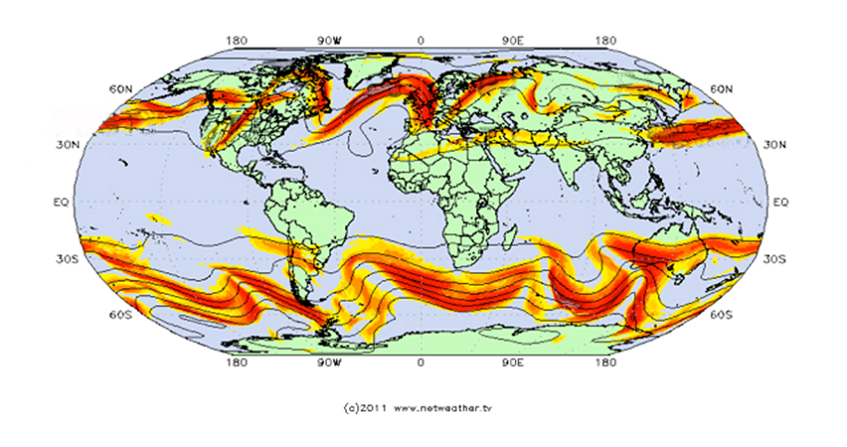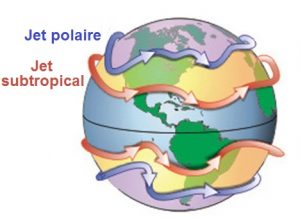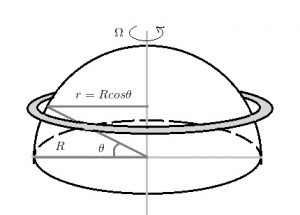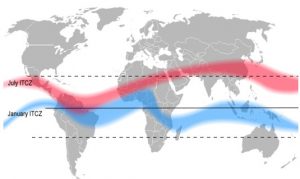Jet streams
PDF
Jet streams, major winds that flow from west to east in the atmosphere, can be explained by analogy with the rotation of skaters on ice. Indeed, these two phenomena have in common a remarkable property of fast rotating movements: the invariance of the angular momentum. Nevertheless, due to friction on the ground in the atmospheric boundary layer and energy withdrawals due to turbulence, the speeds of these winds are significantly lower than the values deduced from this invariance property.
1. From figure skating to jet streams


How does this property of invariance translate into? The well-known example for interpreting and understanding it is the very fast rotation of skaters on ice when they tighten their entire body around their vertical axis (Figure 2). First of all, to start turning, they take a strong support on one of their very bent legs, while keeping the other leg and their arms as far apart as possible. They use their momentum and their average radius r1 made as large as possible (r1 ≈ 0.8 m) to acquire a certain angular velocity ω1 and an initial angular momentum [2] mω1(r1)2, where m denotes the mass of the skater that will remain invariant. Once this is done, they quickly tighten the spread limbs, as shown in Figure 2, reducing their average radius to a value r2 much smaller than r1, say r2 ≃ 0.3 m. To maintain the skater’s kinetic moment, this decrease in radius must be compensated by an increase in angular velocity, which becomes ω2=ω1(r1)2/(r2)2=7ω1. Thus, the skater capable of initially starting at 2 laps per second manages to turn at a speed close to 2 x 7 = 14 laps per second, sufficient for the spectators to have a blurry image of him. However, if the friction of the air is low, the friction of the skate on the ice is high and quickly slows down and stops the skater’s rotation.
As we will see, this invariance property is at the origin of important atmospheric phenomena, including jet streams, the subject of this article. Many other phenomena visible on planets (Saturn’s ring), in stars (concentration of the solar wind towards solar latitudes of 70°) and in galaxies (accretion discs) can also be interpreted using this invariance property.
2. The subtropical jet stream

Let us isolate by thought an air pack subjected to the ascendancy of the equatorial region commented in the article The key role of the trade winds. It leaves the ground with an absolute horizontal speed close to that of the Earth, i.e. 1600 km/h, and rises towards the limit altitude of the troposphere, close to 15 km at this latitude. Absolute speed Va refers to the speed that would see an observer far away in space and not rotating with the Earth; on the contrary, relative speed Vr is the speed that an observer in solidarity with the Earth sees. The air packet then enters one of Hadley’s cells (read Atmospheric Circulation: Its Organization). In this rotating system, its path is necessarily marked by the conservation of its angular momentum [3] (read The laws of dynamics).
The invariance of the angular momentum of this air package is reduced to that of the Var product since the mass m must also be invariant. However, the absolute velocity Va is the sum of the planet’s driving speed, which can be written Ωr by designating by Ω the angular velocity of the Earth, and the relative velocity Vr of the air packet with respect to the Earth. The invariant quantity in this rotating system is therefore: Var = (Ωr+Vr)r. In the vicinity of the equator and at low altitude (zero latitude and zero relative velocity), it is ΩR2 by designating R as the radius of the Earth that is assumed to be spherical. At the top of the troposphere, at an altitude close to 15 km, still a distance from the neighbouring axis of R ≈ 6400km, it can be assumed that it has the same value ΩR2 as at ground level.
In the upper part of the Hadley cell, following the current in the southern plane, the latitude θ increases to values close to ±30° and the distance to the axis becomes r=Rcosθ (see Figure 3). The conservation of the angular momentum then leads to the relationship (ΩR cosθ+Vr)R cosθ =ΩR2, i.e. Vr = ΩR(1-cos2θ)/cosθ. At the latitude of the equator (θ=0), it drives an air flow at a relative speed of zero, which means that the air rotates at the same speed as the solid planet. But at latitude θ=30°, typical of tropical jet stream, this relationship leads to Vr ≃ 0.29 ΩR≃ 460 km/h, which means that the air must then rotate faster than the solid planet. This value is much higher than the actual speed of this wind, which is always less than 100 km/h; but it is quite understandable that the losses of kinetic moment due to friction and turbulence are sufficient to reduce this prediction to a realistic value. These losses are the atmospheric equivalent of the braking of ice skaters.
3. The powerful polar jet stream
It is by far the fastest of the two since it reaches speeds of around 300 km/h; it is also the one we are talking about when we talk about jet stream in the singular. Its average latitude, at the intersection of the Ferrel cell and the polar cell (read Atmospheric circulation: its organization), is close to ±70°. If we applied the relationship seen above with cos θ = 1/2, we would find a relative speed Vr ≃ 2400 km/h. This estimate is not at all justified, because the air packets that reach the top of the troposphere at this latitude do not come from near the equator. Nevertheless, it illustrates the enormous potential for increasing relative speed associated with reducing the distance to the Earth’s axis when latitude becomes large enough.
It has been understood that the air packages arriving at the top of the troposphere at latitudes close to ±70° come either from the Ferrel cell or from the polar regions. The first ones passed near the ground, in the atmospheric boundary layer where friction is high. If they had kept the angular velocity of the planet Ω, their angular momentum would be close to 3ΩR2/4 when they leave the ground. If they reached the top of the troposphere without significant energy dissipation, the same formula would lead to a relative speed Vr ≃ 1600 km/h. As with the tropical jet stream, it is therefore necessary to take friction into account to arrive at a realistic order of magnitude, close to 300 km/h. As for the air supplied by the polar cell, since it comes from the vicinity of the poles, where the distance to the axis is very small, it does not provide as much kinetic moment as the air supplied by the Ferrel cell. Its influence consists mainly in locating the polar convergence zone towards a latitude close to ±70°, between the Ferrel cell where air flows northwards near the ground and the polar cell where it flows southwards.
4. Strongly slowed currents
One may wonder why these currents remain so much slower than the predictions deduced from the conservation of the angular momentum and why they suffer such significant energy losses, to the point of dividing by about 5 the speed of each jet stream. In the case of the subtropical jet, these losses cannot come directly from the viscous friction which is quite negligible in the upper part of the Hadley cell. It is located at an altitude of around 15 km, much higher than the thickness of the atmospheric boundary layer, which is in the order of a few hundred metres. The answer is quite simple: these losses come from the intense turbulent agitation in the updraft of the Inter Tropical Convergence Zone (ICTZ), disrupted by the highly unstable and variable convective movements of the tropical regions. These originate at the interfaces between warm air over continents during the day and cold air over the oceans. The very light currents of warm air rise; the heavier cold currents descend; together they create and maintain large cells with a strong convection movement, very turbulent and often stormy. It is this turbulence that takes a large part of the kinetic energy from the main motion and dissipates it into heat by viscosity, thus slowing the upward current that loses part of its initial angular momentum. This is a consequence of the “doldrums” of tropical regions (read The key role of the trade winds).
In the skater’s example, friction on the ice reduces its rotation in a few seconds, allowing spectators to see the attenuation after several laps at high speed. The mechanism that slows down the polar jet, fed by air that circulates in the vicinity of the ground in the Ferrel cell or in the polar cell, is similar. It is the viscous friction, amplified by local turbulence in the atmospheric boundary layer near the ground, that reduces the initial kinetic moment of the rising air packets up the troposphere at the latitude where the Ferrel cell and the polar cell converge.

These examples of the ice skater and jet streams illustrate the remarkable consequences of preserving the angular momentum in relatively fast rotating mechanical systems. Friction on the ground and in the air, as well as turbulent mixing, are certainly antagonistic mechanisms. Nevertheless, it remains true that this invariance property is at the origin of important atmospheric phenomena, taken into account in the management of transcontinental commercial flights. Thus, to reduce fuel consumption, flights from Europe to the United States bypass the polar jet stream from the north, and return flights are placed in this jet stream.
References and notes
Cover photo: www.netweather.tv, 2011
[1] https://fr.wikipedia.org/wiki/Moment_kinetics_(classical_mechanics)
2] The angular momentum is the product of the mass of the body by its angular velocity in the absolute (or Galilean) reference frame and by the square of its average radius.
[3] https://fr.wikipedia.org/wiki/Moment_kinetics_(classical_mechanics)
The Encyclopedia of the Environment by the Association des Encyclopédies de l'Environnement et de l'Énergie (www.a3e.fr), contractually linked to the University of Grenoble Alpes and Grenoble INP, and sponsored by the French Academy of Sciences.
To cite this article: MOREAU René, FLOR Jan-Bert (January 5, 2025), Jet streams, Encyclopedia of the Environment, Accessed January 21, 2025 [online ISSN 2555-0950] url : https://www.encyclopedie-environnement.org/en/air-en/jet-streams-2/.
The articles in the Encyclopedia of the Environment are made available under the terms of the Creative Commons BY-NC-SA license, which authorizes reproduction subject to: citing the source, not making commercial use of them, sharing identical initial conditions, reproducing at each reuse or distribution the mention of this Creative Commons BY-NC-SA license.







